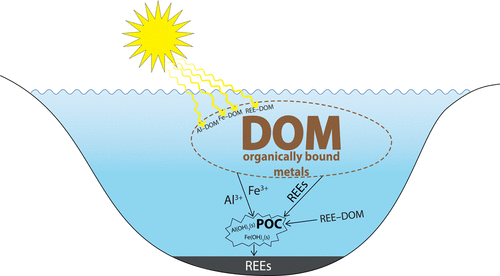当前位置:
X-MOL 学术
›
Environ. Sci. Technol.
›
论文详情
Our official English website, www.x-mol.net, welcomes your
feedback! (Note: you will need to create a separate account there.)
Solar Radiation as the Likely Cause of Acid-Soluble Rare-Earth Elements in Sediments of Fresh Water Humic Lakes.
Environmental Science & Technology ( IF 10.8 ) Pub Date : 2020-01-16 , DOI: 10.1021/acs.est.9b05146 Petr Porcal 1, 2 , Aria Amirbahman 3 , Jiří Kopáček 1, 2 , Stephen A Norton 4
Environmental Science & Technology ( IF 10.8 ) Pub Date : 2020-01-16 , DOI: 10.1021/acs.est.9b05146 Petr Porcal 1, 2 , Aria Amirbahman 3 , Jiří Kopáček 1, 2 , Stephen A Norton 4
Affiliation

|
We studied photochemically induced precipitation of rare-earth elements (REEs) in water from a tributary to Plešné Lake and a tributary to Jiřická Pond, Czech Republic. Both tributaries had high concentrations of dissolved organic matter (∼1.8 mmol C L-1). Filtered (0.2 μm) samples were exposed to artificial solar radiation of 350 W m-2 for 48 to 96 h, corresponding to 3 to 6 days of natural solar radiation in summer at the sampling locations. Experiments were performed with altered and unaltered pH ranging from 3.8 to 6.0. The formation of particulate REEs occurred in all exposed samples with the fastest formation observed at the original pH. The formation of particulate metals continued in irradiated samples after the end of irradiation, suggesting that photochemically induced reactions and/or continuing precipitation continue in darkness or in deeper water due to mixing. Results were compared with paleolimnological records in the Plešné Lake sediment. At pH 5.0, the photochemically induced sediment flux was 3509 nmol m-2 y-1 for Ce, corresponding to 42% of the REEs' annual sediment flux in recent sediment layers. Combining the formation rates obtained in the laboratory irradiation experiments and known 1 day incident solar radiation enabled the estimation of a possible REE sediment flux. For Plešné Lake, the photochemically induced formation of particulate REEs explained 10-44% of the REE concentrations in the upper sediment layers. Observed photochemically induced sequestration of REEs into sediments can explain a significant part of the REEs' history in the Holocene sediment.
中文翻译:

太阳辐射是淡水腐殖质湖泊沉积物中酸溶性稀土元素的可能原因。
我们研究了光化学诱导的从支流到Plešné湖和支流到捷克共和国JiřickáPond的水中稀土元素(REE)的沉淀。两个支流均具有高浓度的溶解有机物(〜1.8 mmol C L-1)。将过滤后的(0.2μm)样品暴露于350 W m-2的人工太阳辐射下48至96 h,相当于夏季在采样地点进行3至6天的自然太阳辐射。在3.8至6.0范围内改变和未改变的pH值进行实验。在所有暴露的样品中均发生了颗粒状稀土元素的形成,在原始pH下观察到最快的形成。辐照结束后,辐照样品中继续形成颗粒金属,这表明由于混合,光化学诱导的反应和/或持续的沉淀在黑暗中或在更深的水中继续发生。将结果与Plešné湖沉积物中的古湖泊学记录进行了比较。在pH 5.0下,铈的光化学诱导沉积物通量为3509 nmol m-2 y-1,相当于最近沉积物层中REEs年沉积物通量的42%。结合在实验室辐射实验中获得的形成速率和已知的1天入射太阳辐射,可以估算可能的REE沉积物通量。对于Plešné湖,光化学诱导的颗粒REE的形成解释了上部沉积物层中REE浓度的10-44%。观察到的光化学诱导的稀土元素螯合到沉积物中可以解释稀土元素的重要部分
更新日期:2020-01-17
中文翻译:

太阳辐射是淡水腐殖质湖泊沉积物中酸溶性稀土元素的可能原因。
我们研究了光化学诱导的从支流到Plešné湖和支流到捷克共和国JiřickáPond的水中稀土元素(REE)的沉淀。两个支流均具有高浓度的溶解有机物(〜1.8 mmol C L-1)。将过滤后的(0.2μm)样品暴露于350 W m-2的人工太阳辐射下48至96 h,相当于夏季在采样地点进行3至6天的自然太阳辐射。在3.8至6.0范围内改变和未改变的pH值进行实验。在所有暴露的样品中均发生了颗粒状稀土元素的形成,在原始pH下观察到最快的形成。辐照结束后,辐照样品中继续形成颗粒金属,这表明由于混合,光化学诱导的反应和/或持续的沉淀在黑暗中或在更深的水中继续发生。将结果与Plešné湖沉积物中的古湖泊学记录进行了比较。在pH 5.0下,铈的光化学诱导沉积物通量为3509 nmol m-2 y-1,相当于最近沉积物层中REEs年沉积物通量的42%。结合在实验室辐射实验中获得的形成速率和已知的1天入射太阳辐射,可以估算可能的REE沉积物通量。对于Plešné湖,光化学诱导的颗粒REE的形成解释了上部沉积物层中REE浓度的10-44%。观察到的光化学诱导的稀土元素螯合到沉积物中可以解释稀土元素的重要部分











































 京公网安备 11010802027423号
京公网安备 11010802027423号